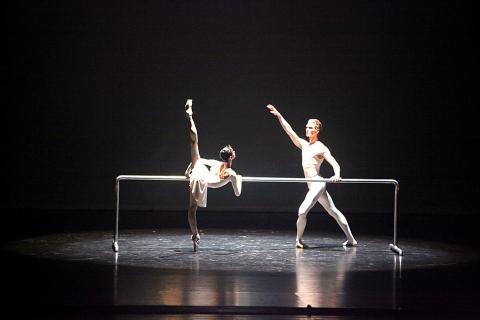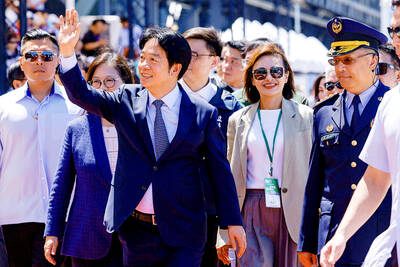Saturday night’s performance of the 7th International Ballet Star Gala (第七屆 國際芭蕾舞星在台北) at the National Theater was an evening of unexpected revelations. While all 12 of the dancers were in fine form, the highlights came from principals of two perhaps lesser-known companies.
Lucia Lacarra and Marlon Dino from the Bayerisches Staatsballett were exquisite in English choreographer Ben Stevenson’s 3 Preludes in the first half of the show. While not a new piece, it was not one I had heard of, much less seen, before.
Stevenson, who headed the Houston Ballet for 27 years, created it for the New York City-based Harkness Youth Ballet in 1969, when he was director of the troupe. It won him the first prize for choreography at the International Ballet Competition in Varna, Bulgaria, in 1972 — and it is easy to see why.

Photo courtesy of Art Wave Inc
The piece, which opens with Lacarra and Dino poised on either side of a ballet barre, was breathtaking both in its simplicity and sheer loveliness. It is set to Sergei Rachmaninoff’s Opus 32, No. 10 and No. 9 and Opus 23.
Stevenson’s choreography allows dancers to show their clean lines — especially during Lacarra’s “6 o’clock” split arabesque — and to display their beautiful extensions. The first prelude revolves around the barre, with each dancer largely sticking to his or her side until Dino begins to lift Lacarra up, over and around the barre, making her appear light as a feather.
The barre is removed after the first prelude, unfettering the pair, but the air of lightness and simplicity remained, each prelude building on the previous one. The dancers and the work were proof that you do not need pyrotechnic techniques at a gala — though there were plenty of examples on Saturday — to shine.
The other revelation of the night came from a last-minute replacement. New York City Ballet’s Ana Sophia Scheller was supposed to dance two classical pieces — the Tchaikovsky and Don Quixote pas de deux — with her colleague Joaquin de Luz. However, she suffered an injury on Dec. 30 and was forced to pull out. She suggested Wang Tzer-shing (王澤馨) try to get Misa Kuranaga from the Boston Ballet instead.
Kuranaga’s crispness and quickness brought a freshness to works that have been seen time and again. In retrospect her performances were even more amazing because Wang said after the show that de Luz and Kuranaga had never danced together before they rehearsed the works on Friday.
The talent and professionalism of both dancers was exemplified in the very flashy fish dives in both pas de deux, with Kuranaga hurling herself across the stage, confident that de Luz was going to be in the right spot to catch her.
Another simple piece that delighted the audience was Jessica Lang’s 2007 Splendid Isolation III, danced by former American Ballet Theater (ABT) principals Irina Dvorovenko and her husband, Maxim Beloserkovsky. The curtain opens on a spotlit Dvorovenko, posed with her back to the audience in a white dress with an absolutely massive skirt that is pooled around her on the floor, while Beloserkovsky lies prone off to the right. The voluminous skirt is cleverly used as both a prop and set dressing until about halfway through the work, when it is unfastened and dropped to reveal a short toga skirt underneath. This work also rated a “wow.”
Mariinsky Theatre’s Igor Kolb got a chance to show his comedic talents in Vladimir Varnava’s solo Beginning, which was inspired by a Rene Magritte painting.
The untitled solo choreographed by Yuri Possokhov and danced by Maria Kochetkova of the San Francisco Ballet — which had its world premiere on Saturday night — might have been the shortest work on the program, but it also allowed her to show a comedic side that she does not often get a chance to display.
ABT principal Daniil Simkin has a big fan base in Taipei because of his repeat appearances at Wang’s galas, and, as expected, his followers roared their approval after his reprise of Ben Van Cauwenbergh’s Le Bourgeois, with its “540os” (a 360o revolution plus a 180o). However, his appearance in the final work on the program, partnering Kochetkova in Le Corsair pas de deux, which included another 540o among his spins, was even more impressive and elicited screams of delight from many in the audience.
This story has been amended since it was first published.

Behind a car repair business on a nondescript Thai street are the cherished pets of a rising TikTok animal influencer: two lions and a 200-kilogram lion-tiger hybrid called “Big George.” Lion ownership is legal in Thailand, and Tharnuwarht Plengkemratch is an enthusiastic advocate, posting updates on his feline companions to nearly three million followers. “They’re playful and affectionate, just like dogs or cats,” he said from inside their cage complex at his home in the northern city of Chiang Mai. Thailand’s captive lion population has exploded in recent years, with nearly 500 registered in zoos, breeding farms, petting cafes and homes. Experts warn the

The unexpected collapse of the recall campaigns is being viewed through many lenses, most of them skewed and self-absorbed. The international media unsurprisingly focuses on what they perceive as the message that Taiwanese voters were sending in the failure of the mass recall, especially to China, the US and to friendly Western nations. This made some sense prior to early last month. One of the main arguments used by recall campaigners for recalling Chinese Nationalist Party (KMT) lawmakers was that they were too pro-China, and by extension not to be trusted with defending the nation. Also by extension, that argument could be

Aug. 4 to Aug. 10 When Coca-Cola finally pushed its way into Taiwan’s market in 1968, it allegedly vowed to wipe out its major domestic rival Hey Song within five years. But Hey Song, which began as a manual operation in a family cow shed in 1925, had proven its resilience, surviving numerous setbacks — including the loss of autonomy and nearly all its assets due to the Japanese colonial government’s wartime economic policy. By the 1960s, Hey Song had risen to the top of Taiwan’s beverage industry. This success was driven not only by president Chang Wen-chi’s

Last week, on the heels of the recall election that turned out so badly for Taiwan, came the news that US President Donald Trump had blocked the transit of President William Lai (賴清德) through the US on his way to Latin America. A few days later the international media reported that in June a scheduled visit by Minister of National Defense Wellington Koo (顧立雄) for high level meetings was canceled by the US after China’s President Xi Jinping (習近平) asked Trump to curb US engagement with Taiwan during a June phone call. The cancellation of Lai’s transit was a gaudy